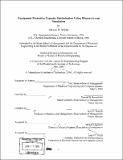| dc.contributor.advisor | Donald B. Rosenfield. | en_US |
| dc.contributor.author | Newlin, Anthony W | en_US |
| dc.contributor.other | Leaders for Manufacturing Program. | en_US |
| dc.date.accessioned | 2006-11-08T16:21:26Z | |
| dc.date.available | 2006-11-08T16:21:26Z | |
| dc.date.copyright | 2000 | en_US |
| dc.date.issued | 2000 | en_US |
| dc.identifier.uri | http://theses.mit.edu/Dienst/UI/2.0/Describe/0018.mit.theses%2f2000-56 | en_US |
| dc.identifier.uri | http://hdl.handle.net/1721.1/34701 | |
| dc.description | Thesis (S.M.)--Massachusetts Institute of Technology, Sloan School of Management; and, (S.M.)--Massachusetts Institute of Technology, Dept. of Electrical Engineering and Computer Science; in conjunction with the Leaders for Manufacturing Program, Massachusetts Institute of Technology, 2000. | en_US |
| dc.description | Also available online at the MIT Theses Online homepage <http://thesis.mit.edu>. | en_US |
| dc.description | Includes bibliographical references (p. 85). | en_US |
| dc.description.abstract | Assembly and Test Manufacturing (ATM) at Intel faces new challenges caused by increased competition, cost pressure, and segmented markets. These forces combine to present ATM with increasing line items and processes in the face of-extreme demand fluctuations over relatively short time periods. As a result, the factories are challenged with accurately planning capacity. Currently, ATM utilizes static, Excel-based models to plan capacity and perform what-if scenarios. The applicability of static models in the highly dynamic ATM environment is questionable. These static models neglect the inherent variability of each tool as well as the coupling of variability between tool sets caused by WIP flow. This prevents static models from predicting the values and variabilities of factory outputs and throughput times (TPT) with sufficient accuracy to optimize the business. Discrete event simulations have the inherent advantage of modeling factory dynamics. They allow for factory experimentation without risking actual production. Examples include availability and run rate improvement impacts, and changes to WIP management policies. Both static and dynamic approaches share a dependency on the accuracy of the input data. In ATM, a few performance parameters are accurately measured in Workstream including output, TPT, queue size, and yield. Tool performance data (availability, failure details, etc.) are not accurately measured because of the low priority placed on this type of data. Parameters such as utilization are back-calculated instead of being measured directly. No attempt is made to capture other important data like tool idle time. This thesis explores the development, validation, and application of a full factory simulation including the consequences of data inadequacies. Tool and factory performance data were gathered in the Costa Rica assembly and test factory for WW28- 34 1999, and were incorporated into a dynamic factory model. Results from simulation using this model underscored the need for automated tool data collection systems by highlighting the inaccuracies of the tool availability data and labor effectiveness. The model also proved useful for exploring WIP policy alternatives (CONWIP limits vs. drum-buffer-rope starts policies). Reduction of CONWIP limits from 4 days to 3 days appeared robust and generated a 20% decrease in TPT. Equipment protective capacity was optimized. The results indicate that the current gap policy of 10/15/20 is sub-optimal and leads to inefficient capital expenditures. The thesis also shows a logical methodology for optimizing protective capacity levels in factories where there are large capital cost differences among toolsets. | en_US |
| dc.description.statementofresponsibility | by Anthony W. Newlin. | en_US |
| dc.format.extent | 113 p. | en_US |
| dc.format.extent | 21673935 bytes | |
| dc.format.extent | 21673693 bytes | |
| dc.format.mimetype | application/pdf | |
| dc.format.mimetype | application/pdf | |
| dc.language.iso | eng | en_US |
| dc.publisher | Massachusetts Institute of Technology | en_US |
| dc.rights | M.I.T. theses are protected by copyright. They may be viewed from this source for any purpose, but reproduction or distribution in any format is prohibited without written permission. See provided URL for inquiries about permission. | en_US |
| dc.rights.uri | http://theses.mit.edu/Dienst/UI/2.0/Describe/0018.mit.theses%2f2000-56 | en_US |
| dc.rights.uri | http://dspace.mit.edu/handle/1721.1/7582 | |
| dc.subject | Sloan School of Management. | en_US |
| dc.subject | Electrical Engineering and Computer Science. | en_US |
| dc.subject | Leaders for Manufacturing Program. | en_US |
| dc.title | Equipment protective capacity optimization using discrete event simulation | en_US |
| dc.type | Thesis | en_US |
| dc.description.degree | S.M. | en_US |
| dc.contributor.department | Leaders for Manufacturing Program at MIT | en_US |
| dc.contributor.department | Massachusetts Institute of Technology. Department of Electrical Engineering and Computer Science | |
| dc.contributor.department | Sloan School of Management | |
| dc.identifier.oclc | 45502472 | en_US |
